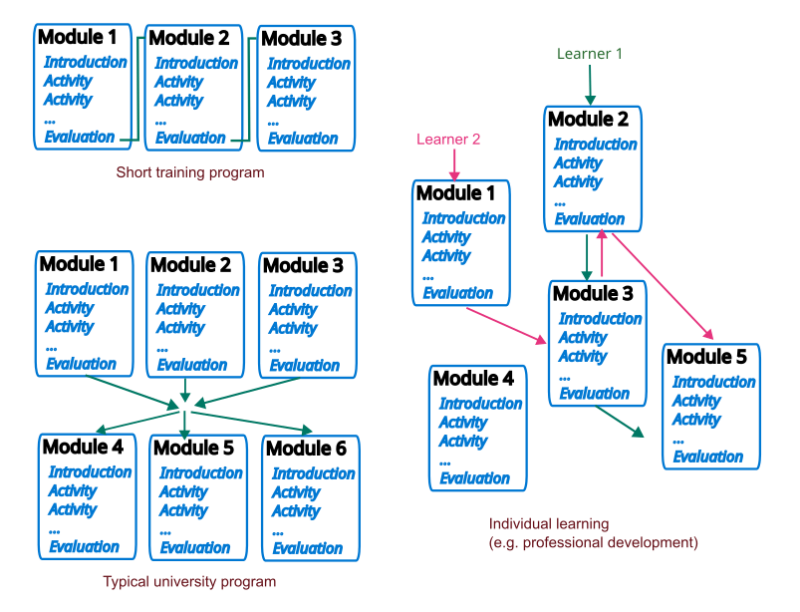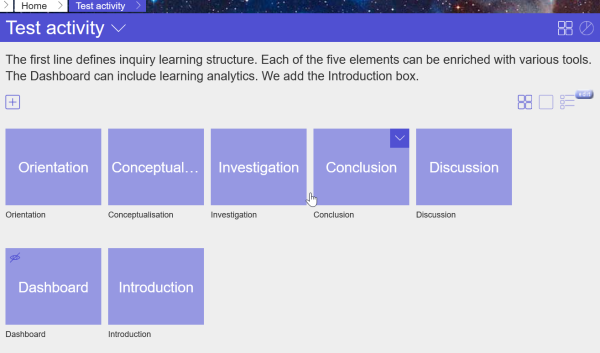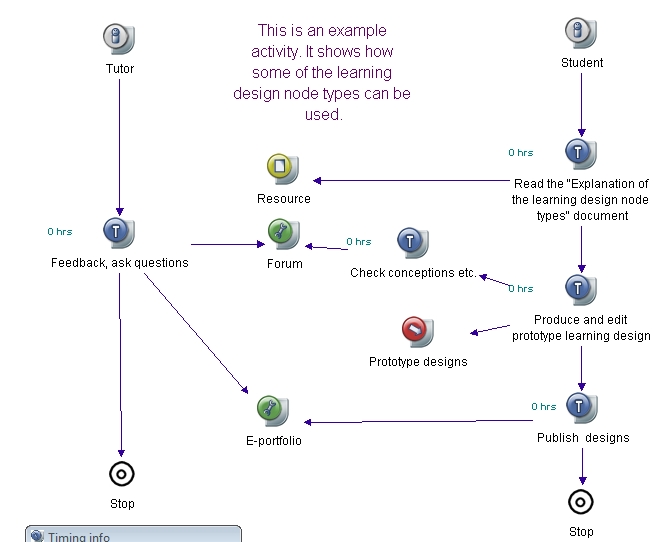Program design and implementation (CAS HEiE) - week 4
DKS:Program design and implementation (CAS HEiE)
Week 4 - Course design and activity design
- Interactive Class: Monday November 7: 17h30 (!!!) - 19h30
- Interactive Class: Wednesday November 9: 16h00 - 18h15
- Public tutoring session: Friday November 11: 16h-18h
We shall re-discuss and re-use some module 2 topics (B. Class) and intensify project work.
What is learning and teaching ?
Recall of some principles:
- Instructional design method made simple: Define goals, define how to evaluate learning, design, implement
- First principle of learning: Learners must be active
- First principle of teaching: Structure the learning experience so that learners engage in learning activities and monitor learning activities
- Fit course design to learning types and levels: Different learning types require different strategies, beginners may need more direct instruction than advanced learners
- Choose the right learning materials: Online and offline textbooks, (interactive) multimedia presentations, computer-supported collaborative activities, computer-based learning tools (exercising, simulations, serious games, etc.)
- Relationship between learning activities, tutoring and learning materials: You can "build" teaching functionality into learning materials, however this is costly and removes flexibility. Any classes should be tutored in one way or another (by a teacher, tutors, or peer tutoring).
- Alignment principle: Learning goals, evaluation strategies and teaching/learning activities must be aligned.
Defining a course structure and organization
A program needs
- a vision that defines general learning outcomes (e.g. become an active citizen) and a fitting global pedagogic strategy
- a set of subject-area specific global learning outcomes (or competences) that typical learners should achieve
- a technical (and physical) infrastructure
- a participatory organisation for program design, implementation and evaluation (see last module of this CAS)
- a course structure (including external courses that students can take)
- certification and accreditation (if possible)
Major types of course structures
In terms of planning we can distinguish macro, meso and micro level.
| Macro
= global learning outcomes & global modularization |
|
||
|---|---|---|---|
| Meso
= course modularization |
|
||
| Micro
= pedagogic scenarization (learning design) |
|
A program can be organized in different ways.
- In a full program, learners typically do between 3 and 10 course in parallel (in the EU in two to eight semesters).
- In continuous training, courses are taken one after each other (but there may be some overlap)
- In individualized learning, paths through courses can be adapted to each learner, but some prerequisites must be respected.
- All setups can be driven by a competency framework.
Discussion:
- What are advantages of standardized programs vs. programs with many choices ?
- Advantages of individual learning paths vs. learning in cohorts ?
- Did any of you experience self-study programs ?
Modes of delivery
- Classic distance teaching with online or offline tutoring,
- Online tele-teaching,
- Online or offline self-learning,
- Blended learning,
- Classroom learning with some distance component (e.g. flipped classrooms, substantial homework)
- Mixed blended, online learning (e.g. one cohort is present, another at distance)
- Classroom learning with some homework
- .....
Activity structures
Learner support and follow-up
- Any good program should implement a tutoring system,
- have a technical infrastructure that supports follow-up (e.g. track student present, assignments, gradebooks)
Learner evaluation models
Formative vs. summative evaluation
A course design should include both formative and summative evaluation:
- Formative evaluation provides feedback to the learner that allows him/her to correct action and progress. In case of failure, you can suggest corrective action.
- Summative evaluation evaluates and grades the state of knowledge with respect to defined learning goals.
You can both at the same time.
In addition, strategic evaluation can precede (what are the needs) or follow (e.g. do learners find jobs) ?
Alignment
Assessment strategy must be aligned with learning goals and learning activities.
- E.g. if the learning goal is acquire applicable skills and the learning activity project-oriented, you must evaluate the project
Program-level decisions
- Each class can define different ways to evaluate students. However, some principles (e.g. using the same grading scale) should be shared. Mass education programs are usually more automatized, therefore most elements should be shared.
- Avoid administering only final exams only in distance education, since many students will not be prepared. In larger classes without strong tutoring, organize at least a mid-term exam plus regular self-evaluation quizzes
Pedagogic strategies
Pedagogic design should be discussed at both program and course level.
- There should be some common principles
- However, different course may address different types of learning and learning levels and will be different.
Learning theory has been discussed in module 2. This week we will look at few pedagogic strategies that are either based on cognitive or social constructivist theory.
Models for Instructional designs
There exist many popular pedagogic strategies and are often published on specialized web sites. Some include models that define learning sequences.
We shall look a few of these.
|
Learning I-II-III |
Major learning content types |
Example designs |
|---|---|---|
|
I: know that |
I-a Facts : recall, description, identification, etc. |
· direct instruction |
|
I-b Concepts: discrimination, categorization, discussion, etc. |
· direct instruction · discovery & exploratory learning | |
|
II: know how |
II-a Reasoning and procedures: inferences, deductions, etc. + procedure application |
· simulation, virtual laboratory (see week 3) |
|
II-b Problem solving and production strategies: identification of sub goals + application of heuristics/methods |
· case-based learning · inquiry-based learning · problem-based learning | |
|
III: knowing in action |
III Situated action: action strategies in complex and authentic situations |
· project-based learning |
|
IV: Other |
IV Other: e.g. motivation, emotion, reflection, i.e. elements that could intervene in all the other categories |
· communal constructivism · learning portfolios |
In some contexts, it can be a good idea to adopt some general, les ambitious framework for structuring learning activities, for example, the 5e learning cycle [1] Many such models do exist. thumb|600x600px|Sam Northern (2019). The 5 E’s of Inquiry-Based Learning. Retrieved, nov 2022 from https://knowledgequest.aasl.org/the-5-es-of-inquiry-based-learning/
| Engage | A demonstration of an event, the presentation of a phenomenon or problem or asking pointed questions can be used to focus the learners' attention. |
| Explore | Learners should take part in activities that allow them to work with materials that give them a 'hands on' experience of the phenomena being observed. |
| Explain | The learner is encouraged to put observations, questions, hypotheses and experiences from the previous stages into language. |
| Elaborate/extend | Learners should be encouraged build and expand upon explanations. Inferences, deductions, and hypotheses can be applied to similar or real-world situations |
| Evaluate | Students reflect on their knowledge (but evaluation should be ongoing and should occur at all stages, in order to determine that learning objectives have been met and problems are detected). |
Direct instruction - 9 events of instruction
Gagnés (1974) [2] nine events of instruction still set the gold standard for "traditional" teaching. It can be applied to both classroom and online teaching.
- Gain attention (ground the lesson, motivate)P
- Present a good problem, a new situation, use a multimedia advertisement, ask questions…
- Describe the goal (frame the information, create expectancies)
- State what will be accomplished, how knowledge can be used, give a demonstration,...
- Stimulate recall of prior knowledge (help connecting)
- … facts, rules, procedures or skills relevant to the current lesson ….
- Present the material to be learned
- e.g. text, graphics, simulations, figures, pictures, sound, etc. Chunk information
- Provide guidance for learning
- Presentation of content is different from instructions on how to learn. Use of different channel (e.g. side-boxes)
- Elicit performance "practice"
- Let the learner do something with the knowledge, practice skills or apply knowledge. At least use MCQ's.
- Provide informative feedback ,
- show correctness of the trainee's response, analyze learner's behavior, maybe present a good (step-by-step) solution of the problem
- Assess performance, test if the lesson has been learned.
- Also provide general progress information
- Enhance retention and transfer :
- e.g. inform the learner about similar problem situations, provide additional practice. Put the learner in a transfer situation...
Project-based learning
Project-based learning can be traced back to pedagogical reformers like Dewey (USA) and also to more radical educators like Freinet (France) who insisted on “real world” anchoring” and "work" as a means of learning. A project-based learning design can be loosely characterized in the following way (Thomas, 2000; Condliffe, et al., 2017):
- Engaging learning experiences that involve students in complex, real-world projects
- Students to draw from many information sources and disciplines in order to solve problems
- Curricular outcomes can be identified before, but outcomes of the student's learning process are neither predetermined nor fully predictable.
- Students engage in inquiry, reflection and revision circles.
- Experiences through which students learn to manage and allocate resources such as time and materials
Typical project-based learning scenario
1. Preparation
- Teacher explicitly identifies and conveys pedagogic intentions (students should know what they will learn from it)
- Choice of the project theme
- Initial Planning
2. Initial definition of the project
- Initial literature review
- Research goals and research questions
- Research and development methodology
- Presentation, evaluation and revision of these
3. Project execution in several phases / cycle
- Students have to present sub-projects and prototypes
- These activities usually include exchange activities between groups
4. Evaluation with precise evaluation rubrics
5. Presentation / Diffusion
Inquiry learning
Inquiry learning (or inquiry-based learning) is a popular strategy in science teaching since it is designed to create "deep knowledge" plus an understanding on how to do research. There exist many variants. The basic model includes five steps that can be repeated: Ask, Investigate, Create, Discuss and Reflect.
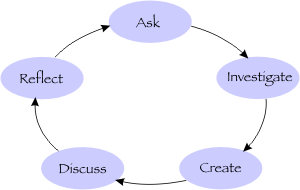
from: The Inquiry Page (dead link)
The next picture shows an example that was used in high-school biology teaching (Lombard)
Below is yet an other variant from the Graasp system, a light-weight platform for developed for STEM teaching (but can be used for other purposes). Per default. it defines an Inquiry learning Sequence as follows:
Below is a structured variant usable in simulation based teaching of the "Dutch School" [3].
| General phases | Processes | Sub-phases | Definition of sub-processes |
|---|---|---|---|
| Orientation |
|
||
| Conceptualization |
|
Questioning | generating research questions based on the stated problem. |
| Hypothesis Generation | generating hypotheses regarding the stated problem. | ||
| Investigation |
|
Exploration | data generation on the basis of a research question. |
| Experimentation | designing and conducting an experiment in order to test a hypothesis. | ||
| Data Interpretation | making meaning out of collected data and synthesizing new knowledge. | ||
| Conclusion |
|
||
| Discussion |
|
Communication | Presenting outcomes of an inquiry phase or of the whole inquiry cycle to others (peers, teachers) and collecting feedback from them. Discussion with others. |
| Reflection | Describing, critiquing, evaluating and discussing the whole inquiry cycle or a specific phase. Inner discussion. |
Those models have in common that learning process starts with a question, which can be further refined during the process. The question usually leads to some form of experimentation.
Successful inquiry learning does require time. E.g. we found that an inquiry learning cycle should last three month before students demonstrated "deep learning".

4C/ID
4C/ID(Merriënboer) is an ambitious instructional design model that attempts to combine project-based learning with direct instruction. It has a focus on whole tasks connected to “real life” or events set in “real life” (like project-based learning) but also include elements of solid instructional systems design. Merrill present a similar design that we present with a figure.
To design the first four phases (activation - demonstration - application - integration), whole tasks have to be broken down into components and the components have to be analyzed. Then one has to decide what should be taught in what way.
Merrill suggests to teach individual components with a direct instruction approach (which is more efficient and often also more effective). Most tasks or problems include five different instructional components. Firstly, initial "telling" should always activate prior knowledge. Demonstration (phase 2) should focus on adequate portrayals of components (but linked to the whole), before the application phase is entered. In the third (application) phase students have to work on skills portrayed and then put "things together" in the forth (integration) phase. Each increasingly difficult whole task (problem) requires going back and forth from (1) demonstration of the whole task (2) to component "teaching" and (2) back to integration. Once the whole task is mastered, this procedure is repeated which the next whole task until the "real world" problem is mastered without much "direct component teaching".
Communal constructivism and contribution oriented pedagogy
A variety of approaches postulate that students can and should contribute to learning materials (in various forms). It can be combined with other forms of project-oriented designs.
Collis & Moonen (2004) [5] define contribution-oriented pedagogy as “approach in which students find, create, submit, and/or share resources using a Web-based course-support environment” and “identified as a model that is particularly valuable for forms of distance and computer-based learning.”. More precisely, the key ideas are “Learners contribute to the learning materials via contributions made available to others in a Web-based system. The others may be others in the same group or others at other times. The others may be at the same or different locations.”
Communal constructivism was conceived in the mid 1990s by Bryn Holmes and collaborators [6] and Leask and Younie [7], It merges ideas from socio-constructivism and "sharing philosophies", e.g. knowledge building and connectivism
The most recent theory that includes learner contributions is connectivism, a kind of learning theory that was created by George Siemens [8]. Together with Steven Downes it also was formulated as teaching theory, e.g. though the design of connectivist MOOCs.
Learning e-portfolios
A learning e-portfolio is a collection of learner works that reflect this personal achievements. E-porfolios can be used in project-oriented teaching but also as a general device to provide a learner with a personal learning environment that will reflect his/her learning over the years or even decades. It can have multiple purposes.
Wade et al. (2005) [9] identified the following pedagogical value and Potential Benefits of Portfolios:
- Student Self-regulation
- Metacognitive self-regulation
- Physical and social environment management
- Time management
- Effort regulation
- Alternative or Authentic Assessment
The best known e-porfolio system in use over the last two decades is Mahara. Quote from the home page (nov 2022): Using Mahara, students and staff create their personal learning stories by uploading evidence of activities they have participated in, and embedding publicly accessible content they have previously put online. They can write reflections on their experiences that frame this evidence, map it to competencies or registration requirements, and provide necessary context. Mahara can be used for many different portfolio purposes, such as study, professional development, work-integrated learning, assessment, showcase and presentation, and employability.
Helen C. Barrett (2000) presents typology of different stages related to multimedia development and which may be adapted to other contexts.
| Portfolio Development | Stages of Electronic Portfolio Development | Content Development |
| Purpose & Audience | 1. Defining the Portfolio Context & Goals | Decide, Assess |
| Collect, Interject | 2. The Working Portfolio | Design, Plan |
| Select, Reflect, Direct | 3. The Reflective Portfolio | Develop |
| Inspect, Perfect, Connect | 4. The Connected Portfolio | Implement, Evaluate |
| Respect (Celebrate) | 5. The Presentation Portfolio | Present, Publish |
Learning design
Learning design is both an activity (people creating teaching/learning activities) and an object (the design). Basically it describes learning objectives, who does what (and (when) using tools and resources, and outcomes.
- Learning design defines an educational sequence (also called scenario, script, activity sequence, ...)
- Learning design should follow usability principles (clear instructions, clear evaluation criteria, etc.). For new types of activities training and onboarding may be required.
- There exist some planning tools (learning design tools, lesson planners, etc)
Typically, a learning design is defined in terms of an activity within a teaching and learning environment. It includes:
- Desired outcomes.
- Roles (e.g. student, tutor)
- that engage in tasks,
- using resources and tools
- and produce outputs.
Below is a screen capture from Compendium LD, a learning design tool.
Worksheets
In particular novice teachers are encouraged to use some activity planning tool to design learning sequences. Simple worksheets that define the following points can do:
- Learning goals
- Resources
- Tools
- A list of activities. Each activity
- defines which tasks learners do using what tools and resources
- has a duration
- Some of these task can be collaborative or collective.
- Should lead to an output (some can be used in further activities, some is graded)
UCL Learning Designer
UCL created a tool that allows defining learning sequences in terms of six different learning types.:
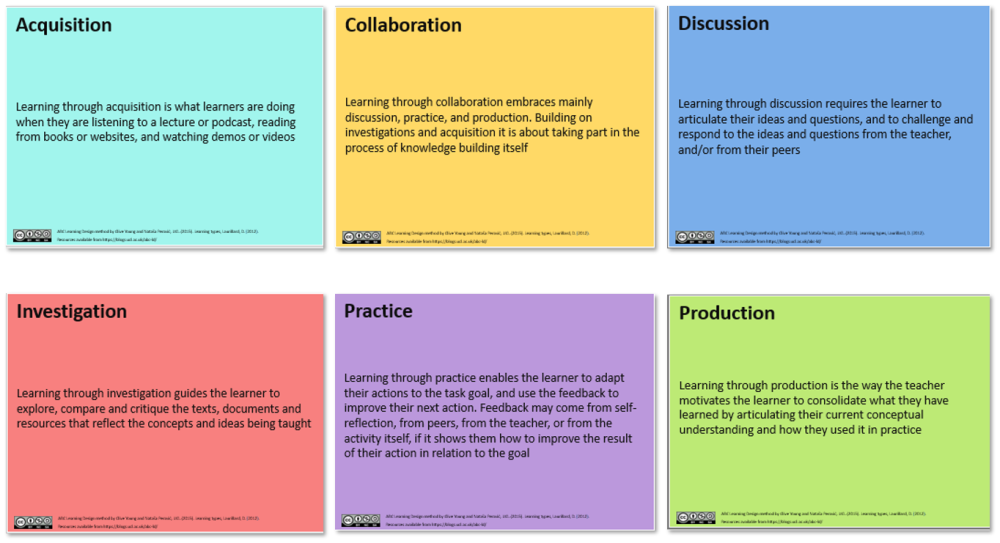
UCL defined learning design tools in both paper and online versions. It allows defining learning sequences that are composed of six types of different learning sequences.
Online learning designer
- This free online tools allows defining learning sequences in terms of Teaching and Learning Activities (TLAs) and sub-activities (tasks according to learning type).
- The designs can be exported to Word or as a backup course to Moodle (but this does require some editing).
- Online URL: https://www.ucl.ac.uk/learning-designer/
ABC LD paper toolkit 2018
- Download link: https://abc-ld.org/download-abc/
Certification and accreditation
TBA
Summary
Program design principles
- Map desired outcomes (e.g. defined as competencies) to teaching/learning modules
- Create a common vision
- Create a working infrastructure (technical, participatory program management,....)
Learning design principles
At all granularity levels (institution, program, module, course, session, activity sequence, activity):
- Analyze needs
- Set goals/skills/expectations
- Choose a design approach/method
- Align goals and assessments
- Choose Strategies
- "Script" your activities with a clear language
- Mediate – predict, manage and take advantage of mediating effects
- Choose and implement resources, tools and environments according to 1, 2, 3, 4 and 5
- Evaluate your teaching/learning environment
- Iterate processes at each level of granularity
Module 3 project
(details to be announced on Wednesday)
(1) Complete the program design form
(2) Finish a sample class in Moodle that includes the following:
- A course description and introduction
- An assignment with an evaluation rubric
- A small competency framework (at system level)
- A small quiz
- At least learning material (IMS or SCORM package, H5P activity or Moodle sequence)
Please check that all sample activities in your Moodle class are done and make sure that all the components are somewhat meaningul.
References
- ↑ Sam Northern (2019). The 5 E’s of Inquiry-Based Learning. Retrieved, nov 2022 from https://knowledgequest.aasl.org/the-5-es-of-inquiry-based-learning/
- ↑ Gagné, R. M. (1974). Essentials of learning for instruction. (2nd ed.). Hinsdale, IL: The Dryden Press.
- ↑ Pedaste, M., Mäeots, M., Siiman, L. A., De Jong, T., Van Riesen, S. A., Kamp, E. T., ... & Tsourlidaki, E. (2015). Phases of inquiry-based learning: Definitions and the inquiry cycle. Educational research review, 14, 47-61.
- ↑ Lombard, F. E., & Schneider, D. K. (2013). Good student questions in inquiry learning. Journal of Biological Education, 47(3), 166-174. doi: 10.1080/00219266.2013.821749 https://www.tandfonline.com/doi/abs/10.1080/00219266.2013.821749
- ↑ Collis, B., & Moonen, J. (2004) Contribution-oriented pedagogy. In P. Rogers (Ed.), Encyclopedia of distance learning, Vol. 1 (pp. 415–422). Harrisburg, PA: Idea Group.
- ↑ Holmes, B., Tangney, B., FitzGibbon, A., Savage, T., & Mehan, S. (2001). Communal Constructivism: Students constructing learning for as well as with others. In J. Price, D. Willis, N. E. Davis, & J. Willis (Eds.), Proceedings of SITE 2001--Society for Information Technology & Teacher Education International Conference. (Vol. 2001, pp. 3114–3119). AACE. Retrieved from https://www.learntechlib.org/p/17346/
- ↑ Leask, M., & Younie, S. (2001). Communal constructivist theory: information and communications technology pedagogy and internationalisation of the curriculum. Journal of Information Technology for Teacher Education, 10(1–2), 117–134. https://doi.org/10.1080/14759390100200106
- ↑ Siemens, G. (2004). Connectivism: A learning theory for the digital age. International Journal of Instructional Technology and Distance Learning, 2(1), 3-10. Retrieved 13:44, 9 March 2011 (CET) from http://www.itdl.org/Journal/Jan_05/article01.htm
- ↑ Wade, Anne, Abrami Philip C., Sclater, Jennifer (2005): An Electronic Portfolio to Support Learning, Canadian Journal of Learning and Technology, Volume 31(3). https://cjlt.ca/index.php/cjlt/article/view/26489/19671
